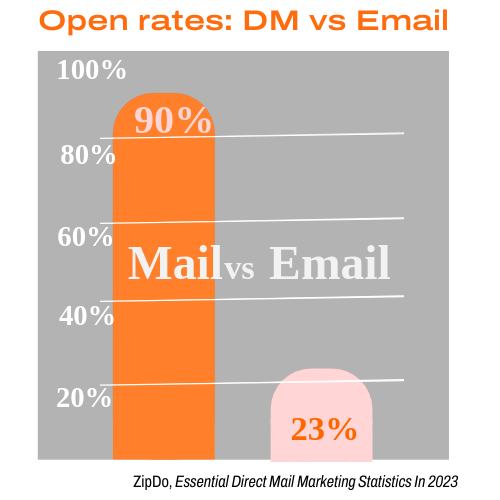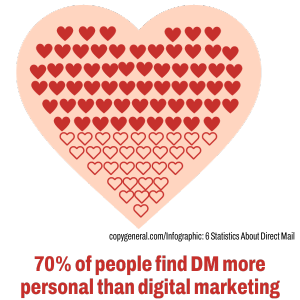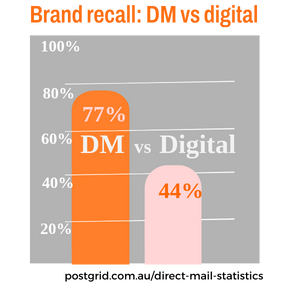
The travel boom of the past couple years is set to continue into 2024 along with the heightened competition for the attention of potential travel customers.
This competition is making it harder than ever to cut through the noise and deliver growth for travel brands. Here are five strategies travel marketers can consider to boost performance in 2024.
2 – Choose the right tool for the job.
3 – Align channel strategy with customer life cycle
1 – Pivot to cut through
Prospective travellers have been overwhemmed by a tidal wave of offers in the past two years. In response they have became much more discerning about the communications they attend to. They also have increasing control over what promotional messages they receive and the digital footprint they leave behind.
Having the best offer in market is no help if no-one is listening. Interactive direct mail is is the cut through champion that engages customers and delivers open rates streets ahead of email..

Research shows up to 90% of addressed mail gets opened compared to an average of 23% for promotional emails. If your audience has tuned out DM can bring them back and re-engage them with your digital travel marketing campaigns.
2 – Choose the right tool for the job
Maslow’s Law of the Instrument states that if all you have is a hammer, everything looks like a nail. It points to a common cognitive bias of over-reliance on familiar tools. The marketing equivalent would be if all you have is digital, everything looks like an EDM. Outperforming your competitors is often a matter of choosing the right tool for the job regardless of the prevailing norms in your industry. After all if you do what everybody’s doing, you’ll get what everybody’s getting.
DM is the right tool for the job when the job calls for:
- Cut through – As noted above DM is significantly more likely to be opened than email. If it’s in your letterbox and has your name on it, you’re going to look at it
- Engagement – DM is the touch point you can touch and delivers unparalleled customer engagement and brand recall
- Action – Direct mail is more likely to prompt behaviour (search, buy, recommend) than any other channel
- Reach – addressed mail can reach every household and business in Australia. There is no mail equivalent of an email opt-out or telephone do-not-call register
- Shelf life – The tangibility of DM means its more likely than any other channel to be kept, reread or passed on to someone else.
- Results – campaigns that combine DM and digital can deliver a 10x multiplier on ROI compared to digital-only campaigns.


3 – Align channel strategy with customer life cycle
Everything, everywhere, all at once
Omnichannel marketing is often misunderstood to mean a continuous active presence in every channel and touch point for every customer. It’s exhausting just thinking about it . Omnichannel doesn’t mean everything, everywhere, all at once. It is better understood as being in the right place at the right time with the agility to pivot as circumstances change. Customer needs and preferences change as they move through purchase and repurchase cycles. Effective travel marketing understands these rhythms and deploys the right mix of messages and channels to eliminate friction and dissolve bottlenecks.
Digital channels are ideal for identifying prospects, assessing their purchase readiness and moving them along the path to purchase. There are low-cost, top-of funnel print tactics, eg unaddressed postcards,. But DM really shines at the bottom of the funnel where its high-engagement characteristics convert qualified prospects into sales. It also builds brand affinity and trust that drive future sales. The personalisation and precise targeting that make DM so powerful are more feasible at the bottom of the funnel . This is because we have had a chance to learn about our customers and their needs.
4 – Focus on ROI not cost
Travel brands are facing a double whammy of increasing costs and declining returns from their digital marketing programs. Paying more and getting less has become the new normal for travel marketers in the digital space. For a long-time digital outperformed every other channel. This conditioned a generation of marketers to expect great results from relatively modest channel investments. Well the free lunch is over, never to return. This seismic shift in performance is prompting a reassessment of offline channels previously dismissed as too expensive. DM is no exception.
When making or recommending channel investments for travel marketing focus on campaign ROI rather than absolute cost. Offline channels can still cause sticker shock for marketers who are used to being able send emails virtually for free. But a channel is no bargain if it doesn’t deliver results. Brands may need to adjust marketing budgets to accomodate activity in offline channels. But, well-executed multi-channel campaigns deliver improvements in ROI measures including cost per lead, cost per acquisition, conversion rate and customer lifetime value.
5 – Work with expert partners
There is nothing magical about DM and it’s certainly possible to waste money on ineffective campaigns. This is especially the case for brands that are unfamiliar with the channel. Working with a direct marketing specialist can minimise these risks. Please note a specialist direct marketing agency is not a mailing house. Direct marketing specialists are experts in data segmentation, personalisation and dynamic content, response rate optimisation, design and production, digital integration and interactive print. Mail houses are experts in printing and distribution.
Conversify are experts in contemporary, digitally integrated direct marketing with a proven track record of success with travel marketing. We’d love to work with you to make 2024 your most successful year to date.
